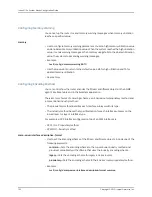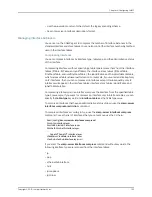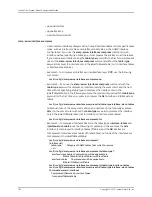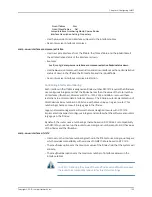
•
Use the
no
version to remove the notification log configuration.
•
See snmp-server notificationLog log.
Recovering Lost Traps
SNMP traps can be lost during startup of the E Series router for one of the following
reasons:
1.
The SNMP agent begins sending SNMP traps to the host before the line module is
initialized.
2.
If the SNMP proxy virtual router is initialized after other virtual routers, traps generated
by the other virtual routers and sent to the proxy router are lost.
To recover SNMP traps that are lost during system startup, the SNMP agent pings the
configured trap host to identify that there is a communication path between E Series
router and host. On successful ping acknowledgment, the lost traps are reconstructed
for each virtual router. In the case of scenario 1, the reconstructed traps are sent to the
proxy virtual router to be routed to the appropriate hosts. In the case of scenario 2, the
traps are sent directly to the appropriate hosts.
You can configure the ping timeout window with the
snmp-server host
command. The
following are guidelines for setting the maximum ping window:
•
If you are losing traps because of scenario 1, base the maximum ping window time on
the estimated time that it takes to establish connectivity in a particular network. (For
some configurations it can take more than 30 minutes to establish connectivity.)
•
If you are losing traps because of scenario 2, we recommend that you use the default
value for the maximum ping window time, which is one minute.
snmp-server host
•
Use to set the ping timeout for the host that is receiving SNMP traps.
•
Use the
pingtimeout
keyword to set the ping timeout window; the range is 1–90
minutes.
•
Example
host1(config)#
snmp-server host 10.10.4.4 pingtimeout 2
•
Use the
no
version to remove the SNMP host.
•
See snmp-server host.
Configuring the SNMP Server Event Manager
The SNMP server event manager works in conjunction with the Event MIB (RFC 2981).
The purpose of this application is to allow many management functions (for example,
fault detection, configuration management, accounting management, and performance
management). These functions are traditionally performed by the network management
Copyright © 2010, Juniper Networks, Inc.
166
JunosE 11.3.x System Basics Configuration Guide
Summary of Contents for JUNOSE 11.3
Page 6: ...Copyright 2010 Juniper Networks Inc vi...
Page 8: ...Copyright 2010 Juniper Networks Inc viii JunosE 11 3 x System Basics Configuration Guide...
Page 24: ...Copyright 2010 Juniper Networks Inc xxiv JunosE 11 3 x System Basics Configuration Guide...
Page 32: ...Copyright 2010 Juniper Networks Inc 2 JunosE 11 3 x System Basics Configuration Guide...
Page 146: ...Copyright 2010 Juniper Networks Inc 116 JunosE 11 3 x System Basics Configuration Guide...
Page 166: ...Copyright 2010 Juniper Networks Inc 136 JunosE 11 3 x System Basics Configuration Guide...
Page 432: ...Copyright 2010 Juniper Networks Inc 402 JunosE 11 3 x System Basics Configuration Guide...
Page 488: ...Copyright 2010 Juniper Networks Inc 458 JunosE 11 3 x System Basics Configuration Guide...
Page 524: ...Copyright 2010 Juniper Networks Inc 494 JunosE 11 3 x System Basics Configuration Guide...
Page 554: ...Copyright 2010 Juniper Networks Inc 524 JunosE 11 3 x System Basics Configuration Guide...
Page 566: ...Copyright 2010 Juniper Networks Inc 536 JunosE 11 3 x System Basics Configuration Guide...
Page 588: ...Copyright 2010 Juniper Networks Inc 558 JunosE 11 3 x System Basics Configuration Guide...
Page 613: ...PART 3 Index Index on page 585 583 Copyright 2010 Juniper Networks Inc...
Page 614: ...Copyright 2010 Juniper Networks Inc 584 JunosE 11 3 x System Basics Configuration Guide...
Page 632: ...Copyright 2010 Juniper Networks Inc 602 JunosE 11 3 x System Basics Configuration Guide...
















































